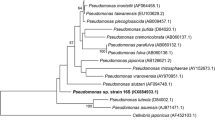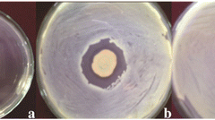Abstract
Bacterial intraspecies and interspecies communication in the rhizosphere is mediated by diffusible signal molecules. Many Gram-negative bacteria use N-acyl-homoserine lactones (AHLs) as autoinducers in the quorum sensing response. While bacterial signalling is well described, the fate of AHLs in contact with plants is much less known. Thus, adsorption, uptake and translocation of N-hexanoyl- (C6-HSL), N-octanoyl- (C8-HSL) and N-decanoyl-homoserine lactone (C10-HSL) were studied in axenic systems with barley (Hordeum vulgare L.) and the legume yam bean (Pachyrhizus erosus (L.) Urban) as model plants using ultra-performance liquid chromatography (UPLC), Fourier transform ion cyclotron resonance mass spectrometry (FTICR-MS) and tritium-labelled AHLs. Decreases in AHL concentration due to abiotic adsorption or degradation were tolerable under the experimental conditions. The presence of plants enhanced AHL decline in media depending on the compounds’ lipophilicity, whereby the legume caused stronger AHL decrease than barley. All tested AHLs were traceable in root extracts of both plants. While all AHLs except C10-HSL were detectable in barley shoots, only C6-HSL was found in shoots of yam bean. Furthermore, tritium-labelled AHLs were used to determine short-term uptake kinetics. Chiral separation by GC-MS revealed that both plants discriminated D-AHL stereoisomers to different extents. These results indicate substantial differences in uptake and degradation of different AHLs in the plants tested.






Similar content being viewed by others
References
Nealson KH, Platt T, Hastings JW (1970) J Bacteriol 104/1:313–322
Fuqua WC, Winans SC, Greenberg EP (1994) J Bacteriol 176:269–275
Pearson JP, Van Delden C, Iglewski BH (1999) J Bacteriol 181:1203–1210
March JC, Bentley WE (2004) Curr Opin Biotechnol 15:495–502
Loh J, Pierson EA, Pierson LS, Stacey G, Chatterjee A (2002) Curr Opin Plant Biol 5
Brelles-Mariño G, Bedmar EJ (2001) J Biotechnol 91:197–209
Whitehead NA, Barnard AML, Slater H, Simpson NJL, Salmond GPC (2001) FEMS Microbiol Rev 25:365–404
Hense BA, Kuttler C, Müller J, Rothballer M, Hartmann A, Kreft J-U (2007) Nat Microbiol Rev 5:230–239
Fekete A, Frommberger M, Rothballer M, Li X, Englmann M, Fekete J, Hartmann A, Eberl L, Schmitt-Kopplin P (2007) Anal Bioanal Chem 387:455–467
Mathesius U, Mulders S, Gao M, Teplitski M, Caetano-Anollés G, Rolfe BG, Bauer WD (2003) PNAS 100:1444–1449
Schuhegger R, Ihring A, Gantner S, Bahnweg G, Knappe C, Vogg G, Hutzler P, Schmid M, Breusegem Fv, Eberl L, Hartmann A, Langebartels C (2006) Plant Cell Environ 29:909–918
Rasmussen TB, Manefield M, Andersen JB, Eberl L, Anthoni U, Christophersen C, Steinberg P, Kjelleberg S, Givskov M (2000) Microbiology 146:3237–3244
Gao M, Teplitski M, Robinson JB, Bauer WD (2003) MPMI 16/9:827–834
Wisniewski-Dyé F, Downie JA (2002) Antonie van Leeuwenhoek 81:397–407
Miller MB, Bassler BL (2001) Rev Microbiol 55:165–199
Conway B, Greenberg EP (2002) J Bacteriol 184/4:1187–1191
Rothballer MH (2003) In situ Lokalisierung, PGPR-Effekt und Regulation des ipdC-Gens der Azospirillum brasilense Stämme Sp7 und Sp245 bei verschiedenen Weizensorten, sowie endophytische Kolonisierung durch Herbaspirillum sp. N3. PhD thesis:Ludwig-Maximilian-University Munich. http://edoc.ub.uni-muenchen.de/archive/00001795/00001701/Rothballer_Michael.pdf
Li X, Fekete A, Englmann M, Götz C, Rothballer M, Frommberger M, Buddrus K, Cai C, Schröder P, Hartmann A, Chen G, Schmitt-Kopplin P (2006) J Chromatogr A 1134:186–193
Eberhard A, Widrig CA, Mc Bath P, Schineller B (1986) Arch Microbiol 146:35–40
Chhabra SR, Stead P, Bainton NJ, Salmond GPC, Stewart GSAB, Williams P, Bycroft BW (1993) J Antibiot 46:441–454
Kaplan HB, Eberhard A, Widrig C, Greenberg EP (1985) J Labelled Compd Radiopharm 22:387–395
Evans EA (1974) Tritium and its compounds. Butterworths, London
Yates EA, Philipp B, Buckley C, Atkinson S, Chhabra S, Sockett R, Goldner M, Dessaux Y, Cámara M, Smith H, Williams P (2002) Infect Immun 70/10:5635–5646
Horwitz W, Kamps LR, Boyer KW (1980) J Assoc Off Anal Chem 63/6:1344–1354
Frommberger M (2005) Entwicklung von Methoden zur Analyse von N-Acyl-Homoserinlactonen durch Kapillartrenntechniken und Massenspektrometrie. PhD thesis, Technical University Munich. http://tumb1.biblio.tu-muenchen.de/publ/diss/ww/2005/frommberger.pdf
Byers JT, Lucas C, Salmond GPC, Welch M (2002) J Bacteriol 184/4:1163–1171
Wang Y-J, Leadbetter JR (2005) Appl Environ Microbiol 71/3:1291–1299
Delalande L, Faure D, Raffoux A, Uroz S, D’Angelo-Picard C, Elasri M, Carlier A, Berruyer R, Petit A, Williams P, Dessaux Y (2005) FEMS Microbiol Ecol 52:13–20
Chhabra SR, Harty C, Hooi DSW, Daykin M, Williams P, Telford G, Pritchard DI, Bycroft BW (2003) J Med Chem 46:97–104
Pomini AM, Araújo WL, Marsaioli AJ (2006) J Chem Ecol 32:1769–1778
Acknowledgments
This work was supported by the GSF additional funding project “Molecular interactions in the rhizosphere” and in part by the Chinese Scholarship Council (CSC). The authors wish to thank B. Look for excellent technical assistance as well as C. Kuttler, L. Lyubenova, M. Diethelm, J. Rohlenová and M. Frommberger for valuable help and advice. The support of U. von Rad and J. B. Winkler is also much appreciated.
Author information
Authors and Affiliations
Corresponding author
Additional information
Christine Götz and Agnes Fekete contributed equally to this publication.
Rights and permissions
About this article
Cite this article
Götz, C., Fekete, A., Gebefuegi, I. et al. Uptake, degradation and chiral discrimination of N-acyl-D/L-homoserine lactones by barley (Hordeum vulgare) and yam bean (Pachyrhizus erosus) plants. Anal Bioanal Chem 389, 1447–1457 (2007). https://doi.org/10.1007/s00216-007-1579-2
Received:
Revised:
Accepted:
Published:
Issue Date:
DOI: https://doi.org/10.1007/s00216-007-1579-2




